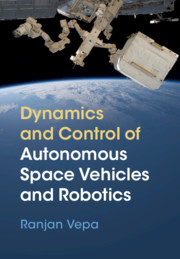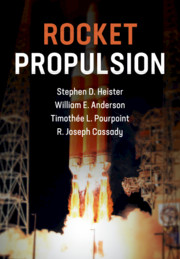Refine search
Actions for selected content:
2076 results in Aerospace engineering
7 - Navigation and Localization
-
- Book:
- Dynamics and Control of Autonomous Space Vehicles and Robotics
- Published online:
- 29 April 2019
- Print publication:
- 02 May 2019, pp 257-307
-
- Chapter
- Export citation
Dedication
-
- Book:
- Dynamics and Control of Autonomous Space Vehicles and Robotics
- Published online:
- 29 April 2019
- Print publication:
- 02 May 2019, pp v-vi
-
- Chapter
- Export citation
Acronyms
-
- Book:
- Dynamics and Control of Autonomous Space Vehicles and Robotics
- Published online:
- 29 April 2019
- Print publication:
- 02 May 2019, pp xvii-xviii
-
- Chapter
- Export citation
Contents
-
- Book:
- Dynamics and Control of Autonomous Space Vehicles and Robotics
- Published online:
- 29 April 2019
- Print publication:
- 02 May 2019, pp vii-xiv
-
- Chapter
- Export citation
2 - Space Vehicle Orbit Dynamics
-
- Book:
- Dynamics and Control of Autonomous Space Vehicles and Robotics
- Published online:
- 29 April 2019
- Print publication:
- 02 May 2019, pp 28-117
-
- Chapter
- Export citation
5 - Kinematics, Dynamics, and Control of Mobile Robot Manipulators
-
- Book:
- Dynamics and Control of Autonomous Space Vehicles and Robotics
- Published online:
- 29 April 2019
- Print publication:
- 02 May 2019, pp 206-228
-
- Chapter
- Export citation
6 - Planetary Rovers and Mobile Robotics
-
- Book:
- Dynamics and Control of Autonomous Space Vehicles and Robotics
- Published online:
- 29 April 2019
- Print publication:
- 02 May 2019, pp 229-256
-
- Chapter
- Export citation
Preface
-
- Book:
- Dynamics and Control of Autonomous Space Vehicles and Robotics
- Published online:
- 29 April 2019
- Print publication:
- 02 May 2019, pp xv-xvi
-
- Chapter
- Export citation
3 - Space Vehicle Attitude Dynamics and Control
-
- Book:
- Dynamics and Control of Autonomous Space Vehicles and Robotics
- Published online:
- 29 April 2019
- Print publication:
- 02 May 2019, pp 118-166
-
- Chapter
- Export citation
4 - Manipulators on Space Platforms
-
- Book:
- Dynamics and Control of Autonomous Space Vehicles and Robotics
- Published online:
- 29 April 2019
- Print publication:
- 02 May 2019, pp 167-205
-
- Chapter
- Export citation

Dynamics and Control of Autonomous Space Vehicles and Robotics
-
- Published online:
- 29 April 2019
- Print publication:
- 02 May 2019

Rocket Propulsion
-
- Published online:
- 21 March 2019
- Print publication:
- 07 February 2019
-
- Textbook
- Export citation
7 - Laser Discharge
-
- Book:
- Energy Deposition for High-Speed Flow Control
- Published online:
- 08 February 2019
- Print publication:
- 21 February 2019, pp 199-242
-
- Chapter
- Export citation
Contents
-
- Book:
- Energy Deposition for High-Speed Flow Control
- Published online:
- 08 February 2019
- Print publication:
- 21 February 2019, pp vii-x
-
- Chapter
- Export citation
1 - Introduction
-
- Book:
- Energy Deposition for High-Speed Flow Control
- Published online:
- 08 February 2019
- Print publication:
- 21 February 2019, pp 1-5
-
- Chapter
- Export citation
2 - Fundamental Equations
-
- Book:
- Energy Deposition for High-Speed Flow Control
- Published online:
- 08 February 2019
- Print publication:
- 21 February 2019, pp 6-27
-
- Chapter
- Export citation
9 - Flow Control in Aerodynamics
-
- Book:
- Energy Deposition for High-Speed Flow Control
- Published online:
- 08 February 2019
- Print publication:
- 21 February 2019, pp 273-336
-
- Chapter
- Export citation
3 - Statistical Mechanics and Continuum Physics
-
- Book:
- Energy Deposition for High-Speed Flow Control
- Published online:
- 08 February 2019
- Print publication:
- 21 February 2019, pp 28-66
-
- Chapter
- Export citation
Appendix B - Physical Constants
-
- Book:
- Energy Deposition for High-Speed Flow Control
- Published online:
- 08 February 2019
- Print publication:
- 21 February 2019, pp 339-340
-
- Chapter
- Export citation
Appendix C - Microwave Frequency Bands
-
- Book:
- Energy Deposition for High-Speed Flow Control
- Published online:
- 08 February 2019
- Print publication:
- 21 February 2019, pp 341-341
-
- Chapter
- Export citation
